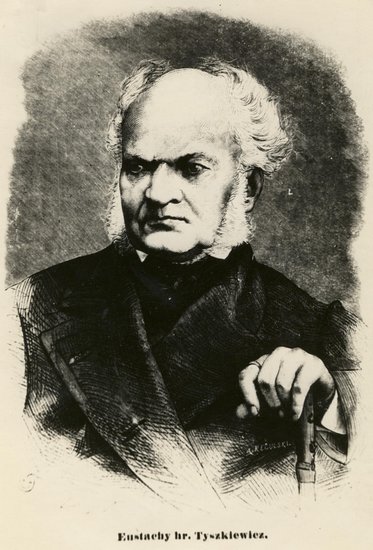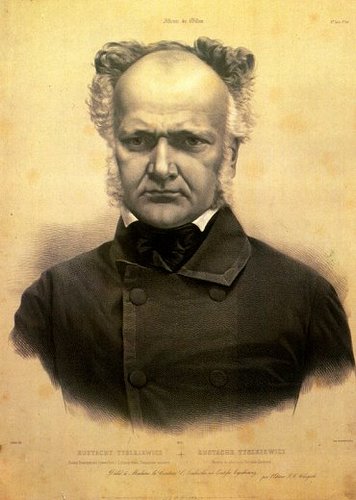Eustachy Tyszkiewicz was born on April 18, 1814, died on August 13, 1873. He was a Belarusian archaeologist, historian, ethnographer, student of local lore, historian, museum curator and one of the founders of scientific archeology in Belarus. He was also an honorary member of the St. Petersburg Academy of Sciences, a member of the Danish Society of Northern Antiquities, the Royal Academy of Fine Arts and Antiquities in Stockholm, the Archaeological Institute of London. Eustachy was the younger brother of Konstanty Piewicz Tyszkiewicz. He was born in Lahojsk.

Almost half of the history of this ancient city was closely associated with the Count Tyszkiewicz family (from 1528), which gave a lot of talented people to Belarusian land: government and military figures, judges, priests, literary men, architects, economists, engineers, etc. His father Pius Felicjanowicz Tyszkiewicz(1756–1858) cared not only about economic matters of the county, but also did a lot to increase cultural heritage of the ordinary city of Lahojsk: he wrote a family chronicle, filled up an art gallery and library, played the violin and flute, organized chamber concerts and recitals, he also was an excellent wood-carver and enchaser and helped his sons Konstanty and Eustachy with their scientific researches.
According to contemporary accounts, the gallery of the city Lahojsk of those days had more than 200 works of Italian painting, a large collection of Etruscan vases, more than 1000 coins and medals, many ancient manuscripts and maps, ancient crosses, armour, shields, swords, spears, poleaxes, a collection of linen products of Logoisk loom factory. The election of 100-year old Pius Tyszkiewicz in 1856 as an honorary member of the Vilnius Archaeological Commission (the unique case) was gratitude and recognition of his contributions to science. Their father’s stories were the first school for history education of the sons.
Since 1824 he studied at the High School in Vilna under the tutelage of University Professors E. Vashkevich and K. Osmolovsky. After interrupting his studies there, he graduated from the Minsk gymnasium in 1831. Then for almost two years he studied on his own, constantly adding to his knowledge in libraries of St. Petersburg.
Since 1833 Eustachy served in the chapter of order in the office of Governor-General of Vilna and then Krakow. Since 1840 he was an Honorary Trustee of schools, Marshal of the Nobility of the Barysau district; with his own funds he built a district school in Barysau; between 1848 and 1854 he was a curator of the Minsk gymnasium. But his main occupation was science. Since 1837, every summer he investigated the burial mounds in Lahojsk, Barysau, Minsk districts, in Drutsk, Lida, Kreva, Mir, Halshany and other places.
Not paying attention to their count titles, the brothers Konstanty and Eustachy, and sometimes their father, picked up shovels and excavated mounds with the help of local peasants.
Sometimes, dressed in a simple peasant dress, they walked through the village and visited houses to listen and write down folk songs, legends, traditions and frank stories about everyday country life, to participate in ceremonies.
Fascinated by mysteries of the ancient world, Eustachy Tyszkiewicz decided to investigate closely the types of historical monuments in their native land and to find out if there was a certain regularity in them and the connection with the culture of the tribes once lived in Belarus. This interest in archaeology came to him at the age of 20.
Like most archaeologists, he began his investigations with the burial mounds. At first Count Tyszkiewicz conducted his excavations in the trench method. But soon he became convinced of the futility of this way and began to use the crossover method of study. His early publications were mostly descriptive. Later the acquired experience gave confidence in the analysis of conclusions and evaluations. He seemed to determine the origin time of the monument by the most insignificant details of the funeral rite and he gave a description of the ancient epoch by findings in burial places. Material and experience gained allowed him to use the comparative-typological method, which was later improved and enriched.
As a result, of investigations of hundreds burial mounds of the Krivichs Tribe and analysis of their burial inventory Eustachy Piewicz was the first who noted defining features of their ethnicity — temple rings worn by women. Thus, he gave a clue to determine the settlement area of the Krivichs.
Analysis of the burial items let him make the conclusions on the trade relations of the Krivichs with the distant lands, where the craft was at such a high level, that the local population provided with iron not only for themselves, but also exported it, that local tools and products were then at the level of the products of adjacent countries. From this it followed, that in the times of the so-called military democracy there was no that barbarism, whose existence was asserted by some historians. Stating the rich and poor inventory of burial mounds, he made the conclusion about the social inequality of society in those times.
Analyzing funeral rites of the Slavs and their neighbors (Lithuanians, Latvians), Eustachy Tyszkiewicz made inference about their similarity (the burning of corpses, the similarity in equipment and its location). And now these findings, supported by more recent archaeological research, are the dominant idea of the unity of the origin of Slavic and Baltic cultures in Belarus.
He considered the term gorodishche (the remains of an ancient settlement) and its derivatives gorodok, gorod (town, city) to be of Slavic origin and he expressed the opinion that settlements were not necessarily defensive fortifications, but rather ritual. He believed that the castles were defensive entities and he deduced their etymology from the word “to close”. Eustachy made a detailed description of stone tools and put their pictures in the appendix to the book Archaeological investigations.
In 1842, he published a book “Rzut oka na źródła archeologii krajowej, czyli opisanie niektórych zabytków starożytności odkrytych w zachodnich guberniach Cesarstwa Rosyjskiego” (The Look at the Sources of the Local Archaeology, or a Description of Some of the Monuments of Antiquity in the Western Provinces of the Russian state).

In 1843, Tyszkiewicz went for training to Denmark, Finland and Sweden, to enhance his knowledge of ancient history and to know about research methods of foreign colleagues in archeology. This was the first and only case in the first half of the XIX century when the Belarusian scientist and archaeologist went abroad to adopt the experience of colleagues. In his research Eustachy made active use of the method of the division of Antiquity according to the three-age system (stone, bronze, iron) of the famous Danish archaeologist K. Thomsen. He used this method for systematization of ancient exhibits in the Lahojsk museum, and later — in the Vilnius Museum of Antiquities. His original book-report Listy o Szwecji (Letters on Sweden) was the result of his trip abroad (Vol. 1–2, 1846).
On his return from abroad, Eustachy Piewicz published his work “The Archaeology of Lithuania” (1872), in which he outlined a wide scope for research of the monuments in Belarus.
His well-grounded work “Opisanie powiatu borysowskiego” (Description of the Barysau District, 1847) was the result of his activity in the Barysau area. For several years, Eustachy Tyszkiewicz gathered original sources on history, geography, ethnography, literature, art, archaeology, toponymy, folklore for his book. He found the co-authors among which there were K.Adamovich, P.Chechot.,Z. Dolengo-Hodokovsky, F. Chahovich, В.Twardowski, J. Wańkowicz, K. Tyshinsky, v. Garnovskii and of course his brother Konstanty. For almost 10 years he created this unique book of local lore, in which every fact, every date was verified, analyzed and argued in good faith.
Working in the field of archeology, ethnography and local history, Eustachy Tyszkiewicz also thoroughly studied folklore. While describing marriage ceremony, rites of Christmas (Rozhdestvo Khristovo), Radonitsa (“Day of Rejoicing”), Savior and the whole cycle of annual household calendar of the Belarusians, he tried to explain the interconnection of pagan rites. Elements of these rites were fixed in christian beliefs. Describing popular celebrations, Eustachy Piewicz emphasized a lack of coincidence of rich spiritual and material life of the Belarusian peasant. About 450 proverbs and sayings were collected and recorded by him in his notes. He asserted:
Folk poetry gives us the opportunity to understand the feelings of the people, and proverbs — to get to know his mind.
He repeatedly placed collections of Belarusian proverbs with the comments of scientists in the magazine “Biblioteka Warszawska”
Count Tyszkiewicz also supplemented his book Examples of household cohabitation in Lithuania (1844, the revised version — in 1864) with neat rhymes, proverbs, legends and traditions. In this book he set forth his views on the culture of aristocracy of former ages.
In his book Nasz Krai (Our Land) Eustachy Tyszkiewicz put an essay about a magnate Radziwiłł. In 1850 he published a work Badania archeologiczne nad zabytkami przedmiotów sztuk i rzemiosł w dawnej Litwie i Rusi Litewskiej (Archaeological research of monuments of arts and crafts, etc., in ancient Lithuania and Lithuanian Russia) in Vilna. Since 1847 Count Eustachy Tyszkiewicz worked in Minsk as a member of the Commission on the collection and publication of ancient acts, deeds and privileges of the cities of Minsk province of the XVI–XVIII centuries. In 1855 he organized and headed the Vilna Archaeological Commission.
It was his cherished dream to create in Vilna (the center of the Belarusian-Lithuanian territory) the first scientifically well-founded museum of antiquity on the basis of the exhibits, collected in the Lahojsk Archaeological Museum. In 1845 he transported part of his Lahojsk collection to Vilnius under the guise of an exhibition which was later turned into a private museum, and then, with the permission of the authorities — into the museum which was located in the old hall of Vilnius University. He was elected Chairman of this museum. The Museum was actively replenished with the exhibits from Minsk, Mogilev, Vitebsk, Orsha, Navahrudak, Kreva, Lida, Pinsk, Braslaw, Pastavy. Eustachy Tyszkiewicz presented his collection (3 thousand books) to the museum and together with his brother Konstanty — the archaeological collection of 2 thousand units. For two years the museum’s collection reached 10 thousand exhibits. In 1856 the museum was officially opened. K. Kirkor prepared the catalogue of the museum.
Recognizing the merits of Eustachy Tyszkiewicz, the scientific community elected him an honorary member of the St. Petersburg Imperial Academy of Sciences. Frightened by the liberation uprising of 1863–64, state administration began to consider the Museum as one of the centers of the «Polish intrigue». In 1864 it was officially banned by order of the Governor-General M. Muravyov. The Vilna Archaeological Commission also ceased its activity. The “harmful” museum’s exhibits were sent to Moscow. Relieved of all his posts, insulted and humiliated, CountTyszkiewicz left Vilna in 1865. Later, thanks to the efforts of the Belarusian archaeologist I. Lutskevich, part of the collection of Eustachy was found and contributed to the fund ofthe Belarusian Museum in Vilna (1921–45).
Eustachy Tyszkiewicz corresponded with many outstanding figures of our country. Among them were the poet and orientalist A. Khodko (Boreyko) and A. Kirkor. At the end of his life he created the album “The Graves of the Tyszkiewicz Family“, published as a separate book in 1873 in Vilnius. Among the extant literary works of Eustachy Piewicz were stylized folk poems, the story Nasz Krai (Our Land) (1871), memories of v. Vankovich., J.Rustem, I.Khodko and others. His works Zelnik dzielnice Borisov, Materiały do historii naszego, some works on archaeology, the collection of documents and others remained in manuscript form. The words of the scientist sound like the precept:
The duty of every educated and enamoured of his land person is to try to explain everything that causes doubt and forms the materials for the national history. To guess, seek and pass on the experience to people means to give a helping hand to those devoted their life and health to sciences for the benefit of the public.
